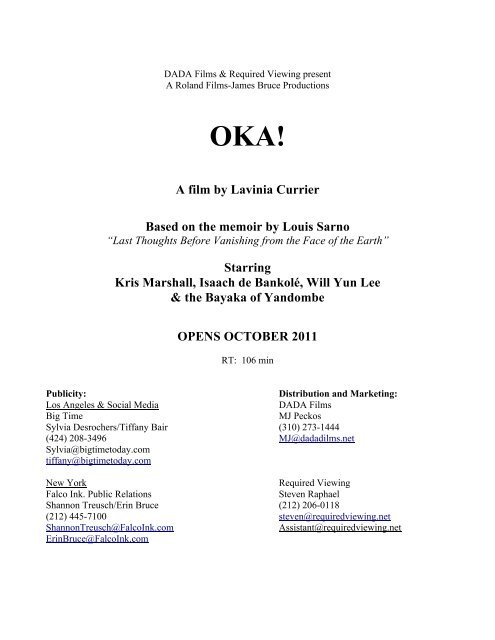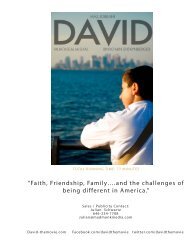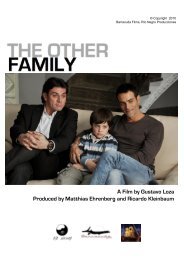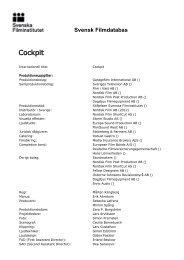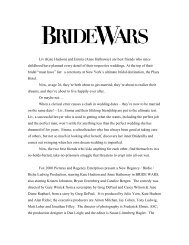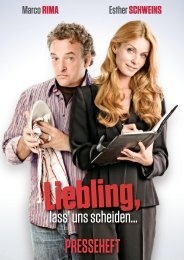A film by Lavinia Currier Based on the memoir by Louis ... - FDb.cz
A film by Lavinia Currier Based on the memoir by Louis ... - FDb.cz
A film by Lavinia Currier Based on the memoir by Louis ... - FDb.cz
You also want an ePaper? Increase the reach of your titles
YUMPU automatically turns print PDFs into web optimized ePapers that Google loves.
DADA Films & Required Viewing present<br />
A Roland Films-James Bruce Producti<strong>on</strong>s<br />
OKA!<br />
A <str<strong>on</strong>g>film</str<strong>on</strong>g> <str<strong>on</strong>g>by</str<strong>on</strong>g> <str<strong>on</strong>g>Lavinia</str<strong>on</strong>g> <str<strong>on</strong>g>Currier</str<strong>on</strong>g><br />
<str<strong>on</strong>g>Based</str<strong>on</strong>g> <strong>on</strong> <strong>the</strong> <strong>memoir</strong> <str<strong>on</strong>g>by</str<strong>on</strong>g> <strong>Louis</strong> Sarno<br />
“Last Thoughts Before Vanishing from <strong>the</strong> Face of <strong>the</strong> Earth”<br />
Starring<br />
Kris Marshall, Isaach de Bankolé, Will Yun Lee<br />
& <strong>the</strong> Bayaka of Yandombe<br />
OPENS OCTOBER 2011<br />
RT: 106 min<br />
Publicity: Distributi<strong>on</strong> and Marketing:<br />
Los Angeles & Social Media DADA Films<br />
Big Time MJ Peckos<br />
Sylvia Desrochers/Tiffany Bair (310) 273-1444<br />
(424) 208-3496 MJ@dadadilms.net<br />
Sylvia@bigtimetoday.com<br />
tiffany@bigtimetoday.com<br />
New York Required Viewing<br />
Falco Ink. Public Relati<strong>on</strong>s Steven Raphael<br />
Shann<strong>on</strong> Treusch/Erin Bruce (212) 206-0118<br />
(212) 445-7100 steven@requiredviewing.net<br />
Shann<strong>on</strong>Treusch@FalcoInk.com Assistant@requiredviewing.net<br />
ErinBruce@FalcoInk.com
SHORT SYNOPSIS<br />
25 years ago, ethnomusicologist <strong>Louis</strong> Sarno traveled from New Jersey to <strong>the</strong> forests of Central<br />
Africa to record <strong>the</strong> music of <strong>the</strong> Bayaka Pygmies. Falling in love with a Bayaka girl and her forest<br />
lifestyle, he decided to stay. “OKA!” tells <strong>the</strong> adventure of his life in Africa with his adopted family.<br />
The Bayaka pygmies maintain a tenuous balance between <strong>the</strong>ir traditi<strong>on</strong>al forest existence and <strong>the</strong>ir<br />
increasing dependence <strong>on</strong> <strong>the</strong> Bantu villagers. Through <strong>the</strong> eyes of Larry, <strong>the</strong> tall, ungainly white man from<br />
New Jersey, who in spite of his failing liver accompanies <strong>the</strong> Bayaka <strong>on</strong> a journey into <strong>the</strong> heart of <strong>the</strong><br />
forest, “OKA!” offers a unique glimpse into <strong>the</strong> music, humor, and spirit of <strong>the</strong> Bayaka people.<br />
“OKA!” is directed <str<strong>on</strong>g>by</str<strong>on</strong>g> <str<strong>on</strong>g>Lavinia</str<strong>on</strong>g> <str<strong>on</strong>g>Currier</str<strong>on</strong>g> and <str<strong>on</strong>g>film</str<strong>on</strong>g>ed in Sango, Akka, French, and English. It is based<br />
<strong>on</strong> <strong>Louis</strong> Sarno’s <strong>memoir</strong>, Last Thoughts Before Vanishing from <strong>the</strong> Face of <strong>the</strong> Earth, and stars Kris<br />
Marshall, with Isaach de Bankolé and Will Yun Lee, and a magnificent local Bayaka ensemble cast.<br />
SYNOPSIS<br />
Ethnomusicologist Larry Whitman (KRIS MARSHALL) is from New Jersey, but his heart is with<br />
<strong>the</strong> Bayaka people of Yandombe, in <strong>the</strong> Central African Republic (CAR). Back in <strong>the</strong> United States <strong>on</strong> a<br />
fundraising trip for his village, his doctor (PETER RIEGERT) warns him that his failing liver will not<br />
withstand <strong>the</strong> dangers of life in <strong>the</strong> African forest. Undaunted, Larry is drawn back to his adopted people.<br />
This is his last chance to record <strong>the</strong> sound of <strong>the</strong> mysterious molimo, an instrument associated in <strong>the</strong> past<br />
with <strong>the</strong> elephant hunt, now thought to be extinct. But Larry knows that <strong>the</strong>re is something more than<br />
music waiting for him.<br />
Even <str<strong>on</strong>g>by</str<strong>on</strong>g> African standards, <strong>the</strong> Central African forest and <strong>the</strong> Bayaka who inhabit it are c<strong>on</strong>sidered<br />
remote and exotic. But times have changed since Larry’s previous visit. The powerful local Bantu Mayor<br />
Bassoun (ISAACH DE BANKOLE) has welcomed a timber corporati<strong>on</strong> to exploit <strong>the</strong> African rainforest for<br />
timber and exotic game. Bassoun calls <strong>the</strong> Bayaka his “little bro<strong>the</strong>rs,” but he’s also moved <strong>the</strong>m from <strong>the</strong><br />
interior of <strong>the</strong> rainforest to a small village <strong>on</strong> <strong>the</strong> outskirts, forbidding <strong>the</strong>m to enter <strong>the</strong>ir sacred traditi<strong>on</strong>al<br />
land. This hasn’t stopped tribal shaman Sataka (MAPUMBA) and his wife Ekadi (ESSANJE) from hunting<br />
and ga<strong>the</strong>ring – in fact, it was Sataka’s prayer that “called” Larry from America to return to <strong>the</strong> Bayaka. As<br />
Larry is welcomed <str<strong>on</strong>g>by</str<strong>on</strong>g> <strong>the</strong> Bayaka, who are eager to receive gifts from <strong>the</strong> outside world, he sees that <strong>the</strong>y<br />
are increasingly marginalized and dependent <strong>on</strong> <strong>the</strong>ir Bantu bosses. Meanwhile, Bassoun welcomes<br />
Chinese businessman Mr. Yi (WILL YUN LEE), who is interested in tapping into <strong>the</strong> vast resources in <strong>the</strong><br />
Bayaka’s protected wilderness. Doing so will require that Bassoun prove <strong>the</strong> Bayaka are poachers: if he<br />
can ga<strong>the</strong>r evidence of <strong>the</strong>m shooting elephants (forbidden <str<strong>on</strong>g>by</str<strong>on</strong>g> law), <strong>the</strong>n perhaps <strong>the</strong> Bayaka could be<br />
disempowered even fur<strong>the</strong>r, leaving <strong>the</strong> forest wide open for cutting.
Although he is plagued <str<strong>on</strong>g>by</str<strong>on</strong>g> fever – as well as attracted to Sataka’s flirtatious teenage granddaughter<br />
Makombe (MBOMBI) – Larry is driven to enter <strong>the</strong> rainforest al<strong>on</strong>e, in search of Sataka. The tribe<br />
eventually aband<strong>on</strong>s <strong>the</strong>ir village and follows him deep into <strong>the</strong> heart of <strong>the</strong> lush, w<strong>on</strong>drous, and dangerous<br />
landscape. An outraged Bassoun orders his men to follow him and bring <strong>the</strong> tribe back to <strong>the</strong> fringes of<br />
civilizati<strong>on</strong>. As <strong>the</strong> various forces c<strong>on</strong>verge, Larry learns <strong>the</strong> secret of <strong>the</strong> mysterious molimo, which<br />
duplicates <strong>the</strong> mating call of an elephant in order to lure <strong>the</strong> mighty animal into an ambush. Torn between<br />
his desire to protect <strong>the</strong> Bayaka from killing an elephant (making a critical error that will jeopardize <strong>the</strong>ir<br />
safety) and h<strong>on</strong>oring <strong>the</strong>ir traditi<strong>on</strong>, Larry c<strong>on</strong>fr<strong>on</strong>ts <strong>the</strong> mysterious inner and outer forces of nature that<br />
ultimately define his soul and help him be healed and find a home forever.<br />
DIRECTOR’S STATEMENT<br />
I wanted to make a <str<strong>on</strong>g>film</str<strong>on</strong>g> which celebrated a people who are perfectly adapted to <strong>the</strong>ir natural<br />
envir<strong>on</strong>ment, and who, despite <strong>the</strong> extreme remoteness and dangers of <strong>the</strong>ir forest home in Central Africa,<br />
always find opportunities to express <strong>the</strong>ir humor, joyfulness and musical genius. Bayaka Pygmy culture is<br />
anarchistic and n<strong>on</strong>-materialist, almost opposite to ours, and yet <strong>the</strong> experience of hunter-ga<strong>the</strong>rers still<br />
res<strong>on</strong>ates with us, having been human’s way of life for most of our history.<br />
I first met <strong>Louis</strong> Sarno 12 years ago, <strong>on</strong> whose life with <strong>the</strong> Bayaka <strong>the</strong> story is based. His self-<br />
effacing humor and his experience with <strong>the</strong> Bayaka for 27 years made him <strong>the</strong> perfect anti-hero to take an<br />
audience into <strong>the</strong> forest and experience <strong>the</strong> magic world of <strong>the</strong> Bayaka.
ABOUT THE PRODUCTION<br />
For generati<strong>on</strong>s, storytellers and artists from around <strong>the</strong> world have found inspirati<strong>on</strong> from <strong>the</strong><br />
landscape and people of <strong>the</strong> African c<strong>on</strong>tinent. Told from a “modern” and “Western” perspective, novels<br />
such as Joseph C<strong>on</strong>rad’s Heart of Darkness, Isak Dinesen’s Out of Africa, or Stanley Livingst<strong>on</strong>’s The Dark<br />
C<strong>on</strong>tinent, often represent a journey to Africa as a temporary state of a descent into man’s primitive and<br />
primal nature – part madness, part enlightenment – but have ignored <strong>the</strong> reality of life for <strong>the</strong> many peoples,<br />
traditi<strong>on</strong>s, and experiences of that complex and misunderstood part of <strong>the</strong> globe.<br />
“OKA!” might seem to have a familiar premise – an ethnomusicologist travels to Africa and<br />
ultimately learns something about himself and his c<strong>on</strong>necti<strong>on</strong> to <strong>the</strong> world through his relati<strong>on</strong>ship with an<br />
ancient and (to him) exotic tribe – but this is no simple “white man’s journey” where <strong>the</strong> hero eventually<br />
must return to his home of origin as a changed man. Ra<strong>the</strong>r, Larry Whitman from <strong>the</strong> outset really feels<br />
like he bel<strong>on</strong>gs am<strong>on</strong>g <strong>the</strong> Bayaka – his trip is not a temporary descent into an unfamiliar world, but a<br />
return home.<br />
The <str<strong>on</strong>g>film</str<strong>on</strong>g> is based <strong>on</strong> <strong>the</strong> life of <strong>Louis</strong> Sarno, an ethnomusicologist who first went to live with <strong>the</strong><br />
Bayaka to record <strong>the</strong> sounds of <strong>the</strong> African rainforest. His initial journeys are documented in his first<br />
<strong>memoir</strong>, S<strong>on</strong>g of <strong>the</strong> Forest, published in 1993, and <strong>the</strong> CD-book Bayaka: The Extraordinary Music of <strong>the</strong><br />
Babenzl Pygmies (1996). For <strong>the</strong> next several years, Sarno worked <strong>on</strong> a sec<strong>on</strong>d <strong>memoir</strong>, which he called<br />
Last Thoughts Before Vanishing from <strong>the</strong> Face of <strong>the</strong> Earth. It was during this time that he first met<br />
<str<strong>on</strong>g>film</str<strong>on</strong>g>maker <str<strong>on</strong>g>Lavinia</str<strong>on</strong>g> <str<strong>on</strong>g>Currier</str<strong>on</strong>g>, serving as her translator when she was doing research for a documentary <strong>on</strong> a<br />
man called Ota Benga. (Benga was a pygmy who was brought to <strong>the</strong> United States as an “exhibit” for <strong>the</strong><br />
1905 World’s Fair, part of a shameful western traditi<strong>on</strong> of exploiting African natives as freaks or oddities).<br />
“While I was in Yandombe, <strong>the</strong> pygmy village, with <strong>Louis</strong> as my translator, a Bayaka asked why I was<br />
doing that story. I explained that it was instructive for us to learn from our mistake, so that kind of racism<br />
doesn’t happen again. But he told me that in Pygmy culture, <strong>the</strong>y like to forget sad things and remember<br />
happy things, so I started to rethink that story from ano<strong>the</strong>r perspective.” She instead asked Sarno if he had<br />
any ideas that would better represent <strong>the</strong> Bayaka, not as an exploited underclass, but as a vibrant and<br />
relevant community, and he suggested she read his unpublished work.<br />
“<strong>Louis</strong> shared real stories about <strong>the</strong> life of <strong>the</strong> Bayaka, like <strong>the</strong> couple who lived deep in <strong>the</strong> forest,<br />
who were almost feral, sleeping in trees. People would bring <strong>the</strong>m supplies and <strong>the</strong> couple would come out<br />
and greet <strong>the</strong>m, but <strong>the</strong>n vanish – <strong>the</strong>y didn’t want to be involved in any of <strong>the</strong> village’s activities. This<br />
became <strong>the</strong> character of Sataka, who is not quite of <strong>the</strong> village,” she says today. “All of <strong>the</strong> characters in<br />
‘OKA!’ were based <strong>on</strong> real people that <strong>Louis</strong> had known, or composites of people. In fact, Mayor Bassoun
is based <strong>on</strong> <strong>the</strong> local area’s previous mayor – who clearly recognized himself in <strong>the</strong> role played <str<strong>on</strong>g>by</str<strong>on</strong>g> Isaach de<br />
Bankole, and was not happy about it.”<br />
Crafting a script with Sarno over <strong>the</strong> course of several years, <str<strong>on</strong>g>Currier</str<strong>on</strong>g> was careful to avoid some of<br />
<strong>the</strong> elements of Sarno’s story that might have simply been “easy” for n<strong>on</strong>-African audiences to embrace.<br />
For example, Sarno really did fall in love with a Bayakan woman and marry into her tribe, but “OKA!”<br />
reduces <strong>the</strong> romance to a more casual flirtati<strong>on</strong> so as not to detract from <strong>the</strong> deeper and more spiritual<br />
aspects of Larry’s journey into <strong>the</strong> rainforest. But <strong>the</strong> most difficult challenge, <str<strong>on</strong>g>Currier</str<strong>on</strong>g> knew, would be<br />
representing both <strong>the</strong> people and <strong>the</strong> regi<strong>on</strong> in <strong>the</strong> most au<strong>the</strong>ntic way possible. The African rainforest is<br />
sec<strong>on</strong>d <strong>on</strong>ly to <strong>the</strong> Amaz<strong>on</strong> basin in size, and rarely explored <str<strong>on</strong>g>by</str<strong>on</strong>g> people from outside <strong>the</strong> area. One such<br />
experienced European was <str<strong>on</strong>g>film</str<strong>on</strong>g>maker Jurgen Steinfurth, who accompanied <str<strong>on</strong>g>Currier</str<strong>on</strong>g> <strong>on</strong> an initial foray into<br />
<strong>the</strong> forest for <str<strong>on</strong>g>film</str<strong>on</strong>g>ing – “Because no <strong>on</strong>e else would go with me,” she remembers today. “On that first trip<br />
in 2008, we <str<strong>on</strong>g>film</str<strong>on</strong>g>ed <strong>the</strong> h<strong>on</strong>ey tree sequence used in <strong>the</strong> <str<strong>on</strong>g>film</str<strong>on</strong>g> – we were <strong>the</strong>re for ten days to see what kinds<br />
of physical and logistical problems we might run into, dealing with <strong>the</strong> wea<strong>the</strong>r and <strong>the</strong> light, as well as<br />
gaining <strong>the</strong> proper permissi<strong>on</strong> to <str<strong>on</strong>g>film</str<strong>on</strong>g>.”<br />
With some footage and shooting experience under her belt, <str<strong>on</strong>g>Currier</str<strong>on</strong>g> and her producti<strong>on</strong> team next<br />
had to try to cast <strong>the</strong> <str<strong>on</strong>g>film</str<strong>on</strong>g>, c<strong>on</strong>vincing actors that traveling to <strong>the</strong> African rainforest and working for several<br />
m<strong>on</strong>ths with minimal accommodati<strong>on</strong>s was worth <strong>the</strong> effort. “No <strong>on</strong>e wanted to go to CAR,” she recalls.<br />
“One of <strong>the</strong> biggest challenges was casting <strong>the</strong> Chinese businessman, Mr. Yi. N<strong>on</strong>e of <strong>the</strong> actors from<br />
China we met would take <strong>the</strong> part – not because <strong>the</strong>y were c<strong>on</strong>cerned about <strong>the</strong> character, or how to<br />
politically finesse <strong>the</strong> situati<strong>on</strong>, but simply because <strong>the</strong>y wanted to be sure <strong>the</strong>y could get bottled water, or<br />
be taken care of if <strong>the</strong>y got sick.” Ultimately, <strong>the</strong> part was given to Will Yun Lee – who is Korean, not<br />
Chinese – but an experienced presence who brings nuance and maturity to a complex supporting role.<br />
Determined to make <strong>the</strong> <str<strong>on</strong>g>film</str<strong>on</strong>g> as eco-friendly as possible, <str<strong>on</strong>g>Currier</str<strong>on</strong>g> worked with envir<strong>on</strong>mental<br />
organizati<strong>on</strong>s such as World Wildlife Fund to reduce <strong>the</strong> <str<strong>on</strong>g>film</str<strong>on</strong>g>’s carb<strong>on</strong> footprint, attempting whenever<br />
possible to hire local crew. Still, to get <strong>the</strong> proper look of <strong>the</strong> <str<strong>on</strong>g>film</str<strong>on</strong>g>, flying in internati<strong>on</strong>al talent was<br />
required. One of <strong>the</strong> key crew members was C<strong>on</strong>rad W. Hall, a veteran cameraman who is <strong>the</strong> s<strong>on</strong> of<br />
legendary, Oscar-winning cinematographer C<strong>on</strong>rad Hall. “C<strong>on</strong>rad had real trouble c<strong>on</strong>vincing his crew to<br />
go to Africa,” <str<strong>on</strong>g>Currier</str<strong>on</strong>g> says. “When <strong>the</strong>y arrived, I w<strong>on</strong>dered how <strong>on</strong> earth <strong>the</strong>se guys decided to come with<br />
us – superb professi<strong>on</strong>als, but <strong>the</strong>y seemed really unsuited to working in Africa.” Though <strong>the</strong> uni<strong>on</strong> crew<br />
was unused to working barefoot in such trying locati<strong>on</strong>s, <strong>the</strong> resulting look <strong>on</strong> screen is remarkable: Hall’s<br />
camera, particularly in <strong>the</strong> final sequences of <strong>the</strong> <str<strong>on</strong>g>film</str<strong>on</strong>g> (which have sparse dialogue as <strong>the</strong> Bayaka pursue <strong>the</strong><br />
elephant and c<strong>on</strong>struct <strong>the</strong> magnificent molimo), reveals <strong>the</strong> truly awesome beauty of <strong>the</strong> rainforest in a<br />
manner that will stun audiences. From <strong>the</strong> vast, epic shots of <strong>the</strong> canopy of trees that disappears into <strong>the</strong><br />
distant horiz<strong>on</strong>, to <strong>the</strong> smallest detail of Sataka ga<strong>the</strong>ring drops of water from a leaf, <strong>the</strong> images in “Oka!”
are as breathtaking, inspiring, and at times terrifying as <strong>the</strong> landscape itself.<br />
“OKA!”’s producer was James (“Jamie”) Bruce, a veteran of <strong>the</strong> TV show “Survivor” who was<br />
used to working <strong>on</strong> major producti<strong>on</strong>s in a remote locati<strong>on</strong>s. “I did pre-producti<strong>on</strong> in Los Angeles,” says<br />
Bruce, “helping raise m<strong>on</strong>ey and do <strong>the</strong> budgets, and <strong>the</strong>n thought I would go to <strong>the</strong> set to do a ‘making of’<br />
<str<strong>on</strong>g>film</str<strong>on</strong>g>. But when I got to CAR, I didn’t pick up my own camera <strong>on</strong>ce – <strong>the</strong>re was simply too much to do <strong>on</strong><br />
behalf of <strong>the</strong> producti<strong>on</strong>.” Trying to simply schedule <strong>the</strong> shoot became difficult in <strong>the</strong> face of political<br />
tensi<strong>on</strong>s in <strong>the</strong> regi<strong>on</strong>s, including upcoming electi<strong>on</strong>s and <strong>on</strong>going political protests, as well as obscure<br />
internati<strong>on</strong>al and regi<strong>on</strong>al laws and regulati<strong>on</strong>s involving commerce, labor, and trade. Resisting bribes and<br />
payoffs would be <strong>on</strong>e of Bruce’s principal challenges, but his presence helped <strong>the</strong> crew deal with such<br />
incidents. “I felt str<strong>on</strong>gly that we had to hire all <strong>the</strong> local people in Bayanga, so I met with <strong>the</strong>ir mayor and<br />
told him I wanted to hire any cars and drivers around, that we’d hire any<strong>on</strong>e willing to work. That ended up<br />
involving and employing almost <strong>the</strong> whole town.” Still, c<strong>on</strong>stant demands for new “taxes” – even though<br />
<strong>the</strong> producti<strong>on</strong> had worked out a deal with <strong>the</strong> nati<strong>on</strong>al government – were obstacles. “Our bank accounts<br />
were frozen, we were shut down three times, with machine guns and oil barrels rolled across our road out,”<br />
remembers Bruce.<br />
It became evident that <strong>the</strong> producti<strong>on</strong> would best commence in <strong>the</strong> late summer of 2009, though<br />
<str<strong>on</strong>g>Currier</str<strong>on</strong>g> and her producti<strong>on</strong> team were skeptical that <strong>the</strong>y could survive <strong>the</strong> wea<strong>the</strong>r. “That’s <strong>the</strong> rainy<br />
seas<strong>on</strong>, and when it rains, it’s very difficult to move. Roads became muddy, and equipment gets fogged up<br />
or moist and stops altoge<strong>the</strong>r. Jurgen told us that shooting in winter was impossible because seas<strong>on</strong>al winds<br />
changed <strong>the</strong> light – in <strong>the</strong> rainy seas<strong>on</strong>, <strong>the</strong> sky gets washed and is incredibly beautiful.”<br />
“Every<strong>on</strong>e kept saying ‘<strong>the</strong> Bayaka will stop <strong>the</strong> rain,’” <str<strong>on</strong>g>Currier</str<strong>on</strong>g> recalls. “I thought ‘oh, cute,’ but<br />
didn’t believe <strong>the</strong>m. But it became a running joke <strong>on</strong> producti<strong>on</strong> – because it was raining, back at <strong>the</strong><br />
producti<strong>on</strong> office all day, and <strong>the</strong> minute I yelled ‘cut’ at <strong>the</strong> end of <strong>the</strong> day, it would start pouring rain <strong>on</strong><br />
set. By <strong>the</strong> end of producti<strong>on</strong>, I realized that we didn’t have any scenes with rain in <strong>the</strong>m – <strong>the</strong> rain always<br />
waited until <strong>the</strong> cameras finished rolling, so <strong>the</strong> Bayaka really did stop <strong>the</strong> rain!”<br />
Taming <strong>the</strong> local elements was part of <strong>the</strong> task: turning <strong>the</strong> real tribe of Bayaka into effective<br />
performers was ano<strong>the</strong>r. “Acting coach Karine Nuris was with us from pre-producti<strong>on</strong>,” says <str<strong>on</strong>g>Currier</str<strong>on</strong>g>,<br />
describing how <strong>the</strong> acting coach would engage in basic movement and ensemble exercises to get <strong>the</strong><br />
Bayaka comfortable and relaxed in fr<strong>on</strong>t of <strong>the</strong> camera. “One of <strong>the</strong> challenges with <strong>the</strong> Bayaka is that <strong>the</strong>y<br />
d<strong>on</strong>’t have <strong>the</strong> same c<strong>on</strong>cept of leadership as we know it – <strong>the</strong>y are anarchistic, egalitarian, not hierarchical<br />
people. They are natural actors and storytellers, <strong>the</strong>y love playing and spoofing and are not shy in any way,<br />
but <strong>the</strong> idea of directing some<strong>on</strong>e else and telling <strong>the</strong>m what to do is not innate.”<br />
<str<strong>on</strong>g>Currier</str<strong>on</strong>g> admits that teaching <strong>the</strong>m how to act <strong>on</strong> cue gave her new insight into <strong>the</strong> people: she had<br />
previously assumed that <strong>the</strong> Bayaka would be unlikely to produce a leader who could represent <strong>the</strong>m to <strong>the</strong>
outside world – “some<strong>on</strong>e to emerge and go to Oxford and become educated and <strong>the</strong>n return to articulate<br />
<strong>the</strong> group’s needs, for example.” But seeing <strong>the</strong>m in fr<strong>on</strong>t of <strong>the</strong> camera changed her perspective: “Given<br />
<strong>the</strong> chance, <strong>the</strong>y were capable of being very forceful, because <strong>the</strong>y were breaking a lot of norms for<br />
<strong>the</strong>mselves in doing <strong>the</strong> <str<strong>on</strong>g>film</str<strong>on</strong>g>. Not just <str<strong>on</strong>g>by</str<strong>on</strong>g> performing, but <str<strong>on</strong>g>by</str<strong>on</strong>g> participating in this new hierarchy. They are<br />
also very individuated, with a broad tolerance for difference, which makes a very interesting ensemble<br />
cast.” She specifically points out seeing <strong>on</strong>e of <strong>the</strong> tribe’s young boys, no more than eight years old, telling<br />
some of <strong>the</strong> older members of <strong>the</strong> cast to be happier, sadder, and show more emoti<strong>on</strong> in <strong>the</strong>ir performances.<br />
But <strong>the</strong> most inspiring member of <strong>the</strong> cast and crew was perhaps British actor Kris Marshall,<br />
playing <strong>the</strong> lead of Larry Whitman. Marshall, a British TV star who would be recognized <str<strong>on</strong>g>by</str<strong>on</strong>g> American<br />
audiences for his role in “Love, Actually,” was already known as a tough customer – he survived a<br />
devastating car accident in 2008 – but what awaited him <strong>on</strong> “OKA!” was unprecedented. “He had<br />
absolutely no c<strong>on</strong>cern for his own well-being,” remembers <str<strong>on</strong>g>Currier</str<strong>on</strong>g>. “Most actors would have g<strong>on</strong>e home<br />
with <strong>the</strong> sickness that he had while we were <str<strong>on</strong>g>film</str<strong>on</strong>g>ing – he had a parasite and <strong>the</strong> threat of dysentery. I told<br />
him he could take sick days to recover, but he said ‘No, this is my job, I want to get it d<strong>on</strong>e.’ He lost fifteen<br />
kilos [over 30 pounds] but just soldiered <strong>on</strong>.” Marshall is also unusual in that he was partially deaf as a<br />
child, and didn’t relate to his character’s desire to capture sound: instead, he immersed himself in learning<br />
<strong>the</strong> language of Akka, and ended up being able to c<strong>on</strong>verse and improvise with <strong>the</strong> Bayaka in a more<br />
natural and engaging manner.<br />
The European and American crew ultimately learned quite a bit about <strong>the</strong>ir subjects. “I had no idea<br />
about <strong>the</strong> Bayaka,” says Jamie Bruce, “but now I understand <strong>the</strong>ir plight is twofold. First, <strong>the</strong>y are forest<br />
people, and if <strong>the</strong> forest is destroyed, <strong>the</strong>y will be destroyed with it – that’s <strong>the</strong> sad reality.<br />
“But <strong>the</strong> positive thing about <strong>the</strong> movie,” adds Bruce, “is that this is not about a white guy coming<br />
to save <strong>the</strong>m – it’s <strong>the</strong> opposite, <strong>the</strong>y save <strong>the</strong> white guy. And that’s what I learned most – <strong>the</strong>y think<br />
differently. They live in <strong>the</strong>ir communities with no formal structure – I think like a scientist, with logic,<br />
proof – and <strong>the</strong>y <str<strong>on</strong>g>by</str<strong>on</strong>g> our standards are living in a surreal world. When Isaach was portraying <strong>the</strong> Mayor,<br />
both <strong>the</strong> Bayaka and <strong>the</strong> Bantu would approach him and say ‘Mr. Mayor, can you do something for us?’ It<br />
was seamless between <strong>the</strong>ir daily life and <strong>the</strong> <str<strong>on</strong>g>film</str<strong>on</strong>g> world – that’s amazing.”<br />
Bruce also admits that he first c<strong>on</strong>sidered <strong>the</strong> <str<strong>on</strong>g>film</str<strong>on</strong>g> a bit more of a comedy – al<strong>on</strong>g <strong>the</strong> lines of “The<br />
Gods Must Be Crazy,” a traditi<strong>on</strong>al “fish-out-of-water” story that plays up<strong>on</strong> <strong>the</strong> clash of cultures to<br />
produce humor. Much of that humor remains, such as in <strong>the</strong> tribe’s c<strong>on</strong>stant nagging of Larry for gifts from<br />
<strong>the</strong> outside world, and <strong>the</strong> stark c<strong>on</strong>trast of Larry’s 6-foot-plus Caucasian frame against <strong>the</strong> backdrop of<br />
dark-skinned tribespeople barely more than five-feet-tall. There is even a “Greek chorus” of three older<br />
tribesmen who comment <strong>on</strong> <strong>the</strong> acti<strong>on</strong>s of Larry while smoking <strong>the</strong>ir pipe, <strong>on</strong>e of <strong>the</strong> <str<strong>on</strong>g>film</str<strong>on</strong>g>’s more notable<br />
examples of ensemble acting that reflects both <strong>the</strong> c<strong>on</strong>structed storyline and <strong>the</strong> au<strong>the</strong>ntic behavior of <strong>the</strong>
Bayakan people. But <strong>the</strong> result is much more than comedic: “The Bayakas took over this movie,” Bruce<br />
says. “They were so au<strong>the</strong>ntic and good, <strong>the</strong> <str<strong>on</strong>g>film</str<strong>on</strong>g> became more poetic and less comedic. They were most<br />
extraordinary to watch, and committed to making <strong>the</strong> story work because of <strong>the</strong>ir relati<strong>on</strong>ship with <strong>Louis</strong> –<br />
who is <strong>on</strong>e of <strong>the</strong>m. So <strong>the</strong>y really embraced Kris as Larry, and embraced <strong>the</strong> <str<strong>on</strong>g>film</str<strong>on</strong>g>.”<br />
The <str<strong>on</strong>g>film</str<strong>on</strong>g> captures <strong>the</strong> imaginati<strong>on</strong> of <strong>the</strong> Bayaka in <strong>the</strong> form of <strong>the</strong>ir music – <strong>the</strong> s<strong>on</strong>gs that <strong>the</strong>y<br />
perform, often associated with ritual and play, echo <strong>the</strong> sounds of <strong>the</strong> rainforest around <strong>the</strong>m. On <strong>the</strong><br />
soundtrack of “OKA!,” Larry’s recordings of <strong>the</strong> sounds of <strong>the</strong> rainforest – <strong>the</strong> wind, rain, chirping birds,<br />
and animal cries – seem to blend seamlessly with <strong>the</strong> percussive and harm<strong>on</strong>ic t<strong>on</strong>es of <strong>the</strong> Bayakan music.<br />
This is particularly captured in <strong>the</strong> final sequence, where <strong>the</strong> legendary instrument <strong>the</strong> molimo is revealed to<br />
resemble <strong>the</strong> mating call of a wild elephant. Though <strong>the</strong> animal is beloved all over <strong>the</strong> world, in <strong>the</strong> wild<br />
<strong>the</strong>y are quite dangerous. “We had a sec<strong>on</strong>d unit and <strong>the</strong>ir job was to <str<strong>on</strong>g>film</str<strong>on</strong>g> all of <strong>the</strong> elephant and difficult<br />
wildlife scenes,” remembers Jamie Bruce. “Alph<strong>on</strong>se Roy Yogeswara is a well-respected Indian<br />
cinematographer who had shot a lot of wildlife, but he’s used to working with a small crew, and C<strong>on</strong>rad<br />
Hall had brought a large crew and a lot of equipment. I was recruited to do some ‘directing’ – when you<br />
see <strong>the</strong> shots of <strong>the</strong> elephants running, that was me chasing <strong>the</strong>m with a plastic bottle making noise right<br />
behind <strong>the</strong>m. If you are chasing <strong>the</strong>m, it’s not so dangerous, as <strong>the</strong>y are unlikely to turn around. But <strong>on</strong>ce<br />
as I was chasing <strong>the</strong>m, suddenly right next to us was ano<strong>the</strong>r elephant off to <strong>the</strong> side, watching us harass his<br />
herd. We had to freeze and not move for ten minutes – <strong>the</strong>n he decided that we were nothing to worry<br />
about and joined <strong>the</strong> o<strong>the</strong>r elephants in <strong>the</strong> clearing. We might call it foolish, but not that dangerous.”<br />
While having ethnomusicologist <strong>Louis</strong> Sarno <strong>on</strong> hand as translator and inspirati<strong>on</strong> for <strong>the</strong> story was<br />
a bo<strong>on</strong> to <strong>the</strong> producti<strong>on</strong>, <strong>the</strong> <str<strong>on</strong>g>film</str<strong>on</strong>g> also benefits from <strong>the</strong> work of musician Chris Berry, who was charged<br />
with making <strong>the</strong> musical sounds of <strong>the</strong> Bayaka into a workable and dramatically c<strong>on</strong>sistent musical score.<br />
A renowned drummer, Berry knew he would have to put his ego aside in order to fully embrace and<br />
understand <strong>the</strong> power of <strong>the</strong> native musical styles. “I think what I tried to accomplish with <strong>the</strong> Bayaka is<br />
not have <strong>the</strong>m feel that <strong>the</strong>y were put under a microscope,” he explains, “but that ra<strong>the</strong>r I was just ano<strong>the</strong>r<br />
musician sharing a musical experience with <strong>the</strong>m.”<br />
“The Bayakan people definitely lead with emoti<strong>on</strong> and intuiti<strong>on</strong>,” says Berry. “Their music is <strong>the</strong><br />
epitome of <strong>the</strong> statement that <str<strong>on</strong>g>Lavinia</str<strong>on</strong>g> made to us about directing <strong>the</strong>m – that <strong>the</strong>y lead with <strong>the</strong>ir emoti<strong>on</strong>s.<br />
That’s <strong>the</strong> c<strong>on</strong>flict if you go into it from a rati<strong>on</strong>al standpoint and treat <strong>the</strong> music as a ‘rati<strong>on</strong>al’ object, but<br />
we were able to break down that boundary. Their music is so unique because it works toge<strong>the</strong>r like an<br />
ecosystem – because <strong>the</strong>y are so close to nature, it just reflects that energy.”<br />
Berry notes that his western ears were not used to <strong>the</strong> complex rhythms of <strong>the</strong> tribe, which are<br />
demarcated <str<strong>on</strong>g>by</str<strong>on</strong>g> a lengthy 64-beat cycle. “Most of our western pop music operates <strong>on</strong> a four or eight bar<br />
cycle – <strong>the</strong> l<strong>on</strong>gest is usually sixteen bars,” he clarifies. “There are very few cultures, most of <strong>the</strong>m related
to forest people, that take 64 pulses before you come back around to <strong>the</strong> beginning of <strong>the</strong> cycle. I’ve found<br />
64 cycle patterns in o<strong>the</strong>r Bantu tribes – and it’s very powerful. These are <strong>the</strong> first people in Africa, and<br />
much of <strong>the</strong> music in Africa descended from <strong>the</strong>m.” The result is moving in more ways than <strong>on</strong>e. “They<br />
d<strong>on</strong>’t have a separate word for music and dance,” says Berry with w<strong>on</strong>der. “When I was <strong>the</strong>re with <strong>the</strong>m, I<br />
was just dancing with <strong>the</strong>m, dance is pure feeling, and I interfaced with <strong>the</strong>m just as much through <strong>the</strong><br />
dancing. I d<strong>on</strong>’t think you can fully understand <strong>the</strong> music if you d<strong>on</strong>’t move to it.”<br />
In <strong>the</strong> end, <strong>the</strong> entire tribe provided both inspirati<strong>on</strong> and instrumentati<strong>on</strong> for <strong>the</strong> score. “The<br />
soundtrack includes all ages, from three to ninety years old,” says Berry. “I think because <strong>the</strong>ir music<br />
crosses generati<strong>on</strong>s, it is undeniably powerful and speaks to every<strong>on</strong>e. They are amazing at reflecting <strong>the</strong>ir<br />
natural world in <strong>the</strong>ir music – a gorilla, a river – <strong>the</strong>y can imitate almost any animal or experience in <strong>the</strong><br />
entire forest. I haven’t met any<strong>on</strong>e in my culture that’s learned how to ‘play a river’ yet – recording <strong>the</strong>m<br />
using <strong>the</strong> river as an instrument in <strong>on</strong>e sequence was absolutely amazing.” Berry will be producing <strong>the</strong><br />
<str<strong>on</strong>g>film</str<strong>on</strong>g>’s soundtrack release.<br />
“OKA!” means “listen.” As much as <strong>the</strong> <str<strong>on</strong>g>film</str<strong>on</strong>g> is <strong>the</strong> story of a unique man who finds his spiritual<br />
home in <strong>the</strong> most distant locati<strong>on</strong>s, it also reflects <strong>the</strong> story of <strong>the</strong> <str<strong>on</strong>g>film</str<strong>on</strong>g>makers who set out to tell a story and<br />
wound up transformed <str<strong>on</strong>g>by</str<strong>on</strong>g> <strong>the</strong> sound of <strong>on</strong>e of <strong>the</strong> planet’s most unique people. Audiences, too, are likely to<br />
be changed simply <str<strong>on</strong>g>by</str<strong>on</strong>g> listening to “OKA!”’s deliberately paced and delicately c<strong>on</strong>structed story of a<br />
journey into an enchanting and exciting place. The sound of <strong>the</strong> African rainforest is <strong>the</strong> sound of our<br />
planet’s heartbeat, brought to colorful life and vivid reality <str<strong>on</strong>g>by</str<strong>on</strong>g> <strong>the</strong> people who live in <strong>the</strong> <strong>on</strong>e of <strong>the</strong> most<br />
vibrant and life-affirming spaces, within reach, if <strong>on</strong>ly we open our ears and our minds to embrace <strong>the</strong>m<br />
with acceptance and joy.
THE CENTRAL AFRICAN REPUBLIC (CAR)<br />
The Central African Republic (CAR) is a landlocked country near <strong>the</strong> exact center of <strong>the</strong> African<br />
c<strong>on</strong>tinent with a populati<strong>on</strong> of 4.4 milli<strong>on</strong>. This territory <strong>the</strong> size of Texas is home to more than 80 ethnic<br />
groups, each with its own language, that include <strong>the</strong> Bayaka pygmies living in its southwestern tropical<br />
forests. More than 35% of its people practice indigenous religi<strong>on</strong>s and <strong>the</strong>ir animistic beliefs and practices<br />
str<strong>on</strong>gly influence <strong>the</strong> Christian majority.<br />
The republic has a str<strong>on</strong>g executive branch (president, vice president, prime minister, and council of<br />
ministers), and weak legislative and judicial branches. Its civil society is very weak with a highly unequal<br />
income distributi<strong>on</strong>. The United Nati<strong>on</strong>s ranks CAR as <strong>on</strong>e of <strong>the</strong> world’s poorest nati<strong>on</strong>s with a Human<br />
Development Index of 159 out of <strong>the</strong> 169 countries with data.<br />
C<strong>on</strong>straints to ec<strong>on</strong>omic development include its land-bound positi<strong>on</strong>, a poor transportati<strong>on</strong> system,<br />
a largely unskilled work force, facti<strong>on</strong>al fighting and a legacy of misdirected ec<strong>on</strong>omic policies.<br />
Hydroelectric plants supply <strong>the</strong> capital Bangui with limited electricity while o<strong>the</strong>r towns rely <strong>on</strong> diesel<br />
generators. Fuel supplies must be barged in <strong>on</strong> <strong>the</strong> Ubangi River or trucked overland through Camero<strong>on</strong>,<br />
resulting in frequent shortages of gasoline, diesel, and jet fuel.
Subsistence agriculture and forestry are <strong>the</strong> backb<strong>on</strong>e of <strong>the</strong> CAR ec<strong>on</strong>omy with about 60% of <strong>the</strong><br />
populati<strong>on</strong> living in outlying areas. The agricultural sector generates more than half of GDP. Over 4,000<br />
Central Africans work in <strong>the</strong> forestry sector, more than in any o<strong>the</strong>r private sector, which accounts for<br />
around 20% of <strong>the</strong> export receipts. The CAR has rich but largely unexploited natural resources of<br />
diam<strong>on</strong>ds, gold, uranium, and o<strong>the</strong>r minerals. Its over 2,000 miles of navigable waterways include <strong>the</strong><br />
primary Ubangi River which joins <strong>the</strong> C<strong>on</strong>go River.<br />
In 2010, CAR became <strong>the</strong> first African country member of <strong>the</strong> Internati<strong>on</strong>al Labor organizati<strong>on</strong><br />
(ILO) to ratify <strong>the</strong> ILO Indigenous and Tribal People C<strong>on</strong>venti<strong>on</strong> 1989 (No. 169 ) that recognizes <strong>the</strong> rights<br />
of all such peoples to be c<strong>on</strong>sulted and to participate fully at all levels of decisi<strong>on</strong>-making that c<strong>on</strong>cern<br />
<strong>the</strong>m.<br />
THE BAYAKA<br />
The Bayaka are a semi-nomadic people that traditi<strong>on</strong>ally survive in <strong>the</strong> forests of southwestern<br />
Central African Republic (CAR), nor<strong>the</strong>rn C<strong>on</strong>go and <strong>the</strong> western C<strong>on</strong>go River basin. These small-sized<br />
people (average 4.5 feet) al<strong>on</strong>g with Baka, BaMbuti, Efe and o<strong>the</strong>r related groups, often called pygmies, are<br />
<strong>the</strong> largest group of hunter-ga<strong>the</strong>rers left <strong>on</strong> earth, estimated at 250,000.<br />
The Bayaka are renowned for <strong>the</strong>ir excepti<strong>on</strong>al knowledge of <strong>the</strong> forest and its animals, insects and<br />
medicinal plants. They rank am<strong>on</strong>g <strong>the</strong> world’s most skilled animal trackers. Their heightened senses can<br />
detect subtle animal tracks even in dense forest foliage. They hunt with large nets while whistling to each<br />
o<strong>the</strong>r like birds to report <strong>the</strong>ir locati<strong>on</strong>s.<br />
Today, most Bayaka spend part of <strong>the</strong> year near a village where <strong>the</strong>y trade <strong>the</strong>ir forest products for<br />
produce, and o<strong>the</strong>r goods. Periodically <strong>the</strong>y return to <strong>the</strong> forest and clear undergrowth for <strong>the</strong>ir camps<br />
under <strong>the</strong> tree canopy. Entire families can fit inside <strong>the</strong>ir waist-high beehive huts fashi<strong>on</strong>ed out of bent<br />
branches covered with large leaves. A distinctive mark of beauty in Bayaka appearance is <strong>the</strong> careful<br />
chipping of <strong>the</strong>ir teeth into pointed triangle shapes.<br />
Music celebrati<strong>on</strong> is highly-valued in Bayaka life. Their frequent call-and-resp<strong>on</strong>se s<strong>on</strong>gs<br />
harm<strong>on</strong>ize with <strong>the</strong> sounds of birds, crickets and cicadas and o<strong>the</strong>r forest life around <strong>the</strong>m. The complexity<br />
of <strong>the</strong>ir music arises from <strong>the</strong>ir amazing ability to reflect <strong>the</strong> complex sounds of <strong>the</strong> forest around <strong>the</strong>m.<br />
Their rich-voiced singing is based <strong>on</strong> pentat<strong>on</strong>ic five-part harm<strong>on</strong>ies organized in 64-beat cycles.<br />
THE CONGO BASIN: THE LOCATIONS FOR OKA!<br />
The C<strong>on</strong>go is <strong>the</strong> earth’s fifth l<strong>on</strong>gest river and Africa’s sec<strong>on</strong>d l<strong>on</strong>gest (after <strong>the</strong> Nile) that drains a<br />
basin of over 1.5 milli<strong>on</strong> square miles from <strong>the</strong> highlands of <strong>the</strong> East African Rift in Zambia to <strong>the</strong> Gulf of<br />
Guinea in <strong>the</strong> Atlantic ocean. It is also <strong>the</strong> world’s deepest river with <strong>the</strong> sec<strong>on</strong>d largest volume of water
(after <strong>the</strong> Amaz<strong>on</strong> River). This mosaic of ecosystems - rivers, forests, savanna, swamps and flooded<br />
forests – holds <strong>on</strong>e-quarter of <strong>the</strong> world’s tropical forests.<br />
Its forests are called <strong>the</strong> earth's "sec<strong>on</strong>d lung" (after <strong>the</strong> Amaz<strong>on</strong> jungles) because <strong>the</strong>y absorb and<br />
store carb<strong>on</strong> dioxide to slow <strong>the</strong> rate of global warming. Their eco-systems also help to regulate <strong>the</strong> flow of<br />
water, protect and enrich soils, c<strong>on</strong>trol diseases, and safeguard water quality. Their dense equatorial<br />
growth c<strong>on</strong>tains an immense diversity of species that extend through almost 500 milli<strong>on</strong> acres. This forest<br />
regi<strong>on</strong> spans <strong>the</strong> boundaries of six African nati<strong>on</strong>s.<br />
The C<strong>on</strong>go basin is <strong>on</strong>e of <strong>the</strong> most important wilderness areas left <strong>on</strong> earth. Coaliti<strong>on</strong>s working to<br />
protect <strong>the</strong> regi<strong>on</strong> face a pressing need to restore ecological balances, reduce <strong>the</strong> human footprint and<br />
support local ec<strong>on</strong>omies. The survival of <strong>the</strong>se magical wilds depends <strong>on</strong> <strong>the</strong> ability of governments,<br />
timber operati<strong>on</strong>s, internati<strong>on</strong>al lending instituti<strong>on</strong>s, and c<strong>on</strong>servati<strong>on</strong> n<strong>on</strong>-governmental agencies to enact<br />
and maintain sustainable envir<strong>on</strong>mental practices.<br />
Many scenes in “OKA!” were <str<strong>on</strong>g>film</str<strong>on</strong>g>ed in <strong>the</strong> Dzanga-Sangha Protected Areas that combine <strong>the</strong><br />
Dzanga-Ndoki Nati<strong>on</strong>al Park and <strong>the</strong> adjacent Dzanga-Sangha Dense Forest Special Reserve. This 5,500-<br />
square-mile wilderness area is home to <strong>on</strong>e of <strong>the</strong> most intact and diverse humid tropical forests <strong>on</strong> <strong>the</strong><br />
planet. Though hunting and logging are prohibited in <strong>the</strong> park, <strong>the</strong> reserve allows <strong>the</strong> Bayaka to hunt and<br />
use <strong>the</strong> forest to meet <strong>the</strong>ir traditi<strong>on</strong>al needs. The protected areas lie about 200 miles southwest of <strong>the</strong> CAR<br />
capital, Bangui, al<strong>on</strong>g a dirt road hacked through <strong>the</strong> jungle. In good wea<strong>the</strong>r, <strong>the</strong> journey from Bangui<br />
takes 15 hours. When <strong>the</strong> rains come, it can take days.<br />
These remote areas are internati<strong>on</strong>ally renowned for <strong>the</strong>ir beauty and remarkable diversity that<br />
include western lowland gorillas, forest elephants, b<strong>on</strong>go antelope, forest buffalo and a multitude of bird<br />
species. The <str<strong>on</strong>g>film</str<strong>on</strong>g>’s memorable cinematography offers rare close-ups of <strong>the</strong>se unique inhabitants.<br />
This landscape is characterized <str<strong>on</strong>g>by</str<strong>on</strong>g> <strong>the</strong> presence of natural forest clearings, or "bai" in <strong>the</strong> Aka language of<br />
<strong>the</strong> Bayaka, that allow easy observati<strong>on</strong> of large mammals. The animals are attracted <str<strong>on</strong>g>by</str<strong>on</strong>g> mineral rich soil,<br />
salt, clay and aquatic plants. The elephant scene in OKA! was <str<strong>on</strong>g>film</str<strong>on</strong>g>ed at <strong>the</strong> Dzanga Bai under <strong>the</strong> guidance<br />
of <strong>the</strong> world’s authority <strong>on</strong> forest elephants, Andrea Turkalo, a field biologist with <strong>the</strong> Wildlife<br />
C<strong>on</strong>servati<strong>on</strong> Society.
The African Forest Elephant of <strong>the</strong> C<strong>on</strong>go Basin<br />
is distinguished from <strong>the</strong> more widely-recognized<br />
savanna elephant <str<strong>on</strong>g>by</str<strong>on</strong>g> its smaller size, rounded ears,<br />
and downward-projecting tusks. These herbivores<br />
comm<strong>on</strong>ly eat fruit, leaves, grass and bark, and<br />
<strong>the</strong>ir dung disperses seeds that allow reforestati<strong>on</strong>.<br />
Its 22-m<strong>on</strong>th gestati<strong>on</strong> produces a calf that weighs<br />
200 pounds at birth, nurses for three years and<br />
remains dependent <strong>on</strong> its mo<strong>the</strong>r for 8 to 10 years.<br />
Forest elephants are very social animals that learn<br />
what to eat, where to find water and how to behave<br />
from <strong>the</strong>ir mo<strong>the</strong>rs and older bulls. A typical adult<br />
will daily c<strong>on</strong>sume 450 pounds of food and up to 50<br />
gall<strong>on</strong>s of water. Its life expectancy is 70 years.<br />
WILDLIFE FEATURED IN OKA!<br />
The Black Mamba is <strong>the</strong> l<strong>on</strong>gest venomous snake in Africa growing up to 15 feet<br />
in length. Its name derives from <strong>the</strong> ink- black coloring of its mouth, although <strong>the</strong><br />
outer skin varies from a gray to a dullish yellow-green. This shy creature is <strong>the</strong><br />
world’s fastest snake capable of moving up to 12 miles per hour. It will seek to<br />
escape c<strong>on</strong>fr<strong>on</strong>tati<strong>on</strong>s, but if cornered mimics a cobra <str<strong>on</strong>g>by</str<strong>on</strong>g> spreading a neck-flap,<br />
exposing its black mouth, and hissing. If this fails to scare away attacker, <strong>the</strong> black<br />
mamba will strike repeatedly, injecting large amounts of venom. Its pois<strong>on</strong> causes<br />
100% human mortality within 30 minutes if not treated with anti-venom.<br />
The B<strong>on</strong>go is <strong>the</strong> largest and heaviest forest antelope. Both males and<br />
females have spiraled lyre-shaped horns. The large ears are believed to<br />
sharpen hearing, and <strong>the</strong> distinctive colorati<strong>on</strong> may help b<strong>on</strong>gos<br />
identify <strong>on</strong>e ano<strong>the</strong>r in <strong>the</strong>ir dark forest habitats. It has no special<br />
secreti<strong>on</strong> glands and so relies less <strong>on</strong> scent to find <strong>on</strong>e ano<strong>the</strong>r than do<br />
o<strong>the</strong>r similar antelopes. Both males and females have spiraled lyreshaped<br />
horns and a hunched posture, with <strong>the</strong> head held up and <strong>the</strong><br />
horns extended al<strong>on</strong>g <strong>the</strong> back. Male b<strong>on</strong>gos are solitary, seeking out<br />
females <strong>on</strong>ly during mating seas<strong>on</strong>. Females and young live in nursery<br />
herds. Timid and easily frightened, b<strong>on</strong>gos will run away at<br />
c<strong>on</strong>siderable speed, even through dense undergrowth.<br />
The Forest Cobra is <strong>the</strong> sec<strong>on</strong>d largest cobra species <strong>on</strong> earth, reaching<br />
lengths of up to 9 feet in <strong>the</strong> tropical forests of Central Africa. This predator<br />
can deliver a very powerful bite with it hollow, fixed fangs through which it<br />
injects deadly venom. Its mating behavior includes male ritual combat where<br />
two males literally "dance" with each o<strong>the</strong>r to determine who wins <strong>the</strong> right to<br />
mate with <strong>the</strong> female cobra. Once a male has established dominance <strong>the</strong> loser<br />
will generally move <strong>on</strong>. Juvenile cobras however must beware of larger adults<br />
because <strong>the</strong>y are cannibalistic and will eat smaller snakes.
The<br />
Hippopotamus is a semi-aquatic mammal living in groups<br />
of up to 40 animals with territorial bulls presiding over a<br />
stretch of river and groups of females and young. Adults<br />
average 11 ft l<strong>on</strong>g, 5 ft tall at <strong>the</strong> shoulder, and weigh from<br />
13,300 to 7,000 lbs with a specific gravity that allows it to<br />
sink and walk or run al<strong>on</strong>g river bottoms. Despite its stocky<br />
shape and short legs, this aggressive animal can outrun a<br />
human. Its closest living relatives are cetaceans (whales,<br />
porpoise, etc.) from which <strong>the</strong>y diverged 55 milli<strong>on</strong> years<br />
ago.<br />
The Brush-Tailed Porcupine is a rodent that frequents <strong>the</strong> forests of West and<br />
Central Africa. With an average weight of six pounds, it is a favorite source of<br />
meat and thus hunted in large quantities. It has an el<strong>on</strong>gated rat-like face and<br />
body and short legs, tipped with clawed and webbed feet. Unlike most o<strong>the</strong>r<br />
porcupines, <strong>the</strong> brush-tailed porcupine has lighter and smaller quills.<br />
The Western Lowland Gorilla of Central Africa is <strong>the</strong> most widespread and numerous of all<br />
gorillas. Although it stands erectly up to 5ft 7 in. tall and weigh up to 400 pounds, it can climb<br />
up over 100 feet to feed <strong>on</strong> leaves or fruits. The adult male is called a "silverback" due to <strong>the</strong><br />
distinctive silver-gray hairs <strong>on</strong> its back; <strong>the</strong> o<strong>the</strong>rs have brownish gray fur with reddish<br />
highlights. It lives in families of <strong>on</strong>e dominant male, five to seven adult females, children and<br />
adolescents, and possibly a few n<strong>on</strong>-dominant males within a home range of three to 18 miles.<br />
Families grow slowly because females tend to produce babies every five years <strong>on</strong>ly starting at<br />
<strong>the</strong> age of nine or ten.
KRIS MARSHALL (Larry)<br />
ABOUT THE CAST<br />
Kris Marshall began acting at an early age and made his TV debut in <strong>the</strong> British police series The<br />
Bill. He was raised in Malmesbury, Wiltshire, UK; H<strong>on</strong>g K<strong>on</strong>g and Canada, and educated at Wells<br />
Ca<strong>the</strong>dral School. His work in children's <strong>the</strong>atre in Ascot led to touring producti<strong>on</strong>s of Agatha Christie. His<br />
persistence landed him a role in <strong>the</strong> play Journey's End, staged above a L<strong>on</strong>d<strong>on</strong> pub, which attracted an<br />
agent. His major breakthrough came in 2000 as oldest-s<strong>on</strong> Nick Harper in <strong>the</strong> BBC sitcom My Family that<br />
earned him <strong>the</strong> Best Newcomer prize at <strong>the</strong> 2002 British Comedy Awards. During <strong>the</strong> following run of<br />
successful TV, stage and <str<strong>on</strong>g>film</str<strong>on</strong>g> appearances, Marshall suffered severe head injuries in April 2008 when a<br />
car flung him 12 feet outside a night club in Bristol. He miraculously recovered in time to begin his<br />
acclaimed performance as Carter in <strong>the</strong> UK run of playwright Neil LaBute’s American play Fat Pig <strong>on</strong>ly<br />
weeks later.<br />
His numerous <str<strong>on</strong>g>film</str<strong>on</strong>g> roles include <strong>the</strong> unlikely playboy Collin Frissel in Love Actually, Troy in <strong>the</strong><br />
UK versi<strong>on</strong> of Death at a Funeral, Gratiano in <strong>the</strong> 2004 <str<strong>on</strong>g>film</str<strong>on</strong>g> Merchant of Venice with Al Pacino and<br />
Jeremy Ir<strong>on</strong>s, and Dr. Gude<strong>on</strong> in Iris starring Judy Dench. His most recent roles include Ethan who<br />
seduces American women with his British accent in Fox TV’s 2011 sitcom, Traffic Light, and <strong>the</strong> best man<br />
in an Australian outback wedding in Stephen Elliot’s <str<strong>on</strong>g>film</str<strong>on</strong>g> A Few Best Men with Olivia Newt<strong>on</strong>-John due<br />
for release in 2012.<br />
Marshall has earned a near cult following playing “Adam” whose relati<strong>on</strong>ship with “Jane” as <strong>the</strong><br />
“BT Couple” has generated several years of quirky British telecommunicati<strong>on</strong> ads. Half a milli<strong>on</strong> viewers<br />
recently voted to choose Jane’s wedding dress, <strong>the</strong>ir car and s<strong>on</strong>g before <strong>the</strong> “couple” <str<strong>on</strong>g>film</str<strong>on</strong>g>ed <strong>the</strong> “marriage<br />
cerem<strong>on</strong>y” with fans who competed to appear as <strong>the</strong> wedding guests (to air during <strong>the</strong> 2011 Britain’s I’ve<br />
Got Talent competiti<strong>on</strong>.)<br />
ISAACH DE BANKOLÉ (Mayor Bassoun)<br />
Isaach de Bankolé was born in Abidjan, Côte d'Ivoire in 1957 to parents from <strong>the</strong> West African<br />
country of Benin. He arrived in Paris at age 17 to study engineering and become an airplane pilot. Instead<br />
de Bankolé earned a degree in Acting from Cours Sim<strong>on</strong> of Paris, <strong>on</strong>e of <strong>the</strong> oldest and most prestigious<br />
<strong>the</strong>atrical training schools for professi<strong>on</strong>al actors in France, and a master’s degree in ma<strong>the</strong>matics from <strong>the</strong><br />
Universite de Paris. De Bankolé w<strong>on</strong> a César (<strong>the</strong> nati<strong>on</strong>al French <str<strong>on</strong>g>film</str<strong>on</strong>g> awards) for most promising actor as<br />
Lemi in <strong>the</strong> French comedy Black Mic Mac (1986). His first major role was that of Protee in Claire Denis'<br />
Chocolat (1988), an intelligent and cultured African servant erotically drawn to his married Caucasian<br />
mistress. In 1998, he relocated to New York City after a shift from French <str<strong>on</strong>g>film</str<strong>on</strong>g>s to working with foreign
directors.<br />
He has appeared in over 30 <str<strong>on</strong>g>film</str<strong>on</strong>g>s, including four <str<strong>on</strong>g>by</str<strong>on</strong>g> Jim Jarmusch portraying <strong>the</strong> Parisian cab driver<br />
in Night <strong>on</strong> Earth (1991); Raym<strong>on</strong>d in Ghost Dog: The Way of <strong>the</strong> Samurai (1999); Isaach in <strong>the</strong> “No<br />
Problem” segment of Coffee and Cigarettes (2003) and <strong>the</strong> “L<strong>on</strong>e Man” assassin in The Limits of C<strong>on</strong>trol<br />
(2009). Bankole’s credits also include Laurent in Julian Schnabel’s Diving Bell and <strong>the</strong> Butterfly (2007);<br />
Timothy in Lars v<strong>on</strong> Trier's Manderlay (2005), and <strong>the</strong> terrorist Steven Obanno in <strong>the</strong> James B<strong>on</strong>d <str<strong>on</strong>g>film</str<strong>on</strong>g><br />
Casino Royale (2006).<br />
In <strong>the</strong> U.S. he is best known for his recurring role in <strong>the</strong> seventh seas<strong>on</strong> of <strong>the</strong> TV series 24 as Ule<br />
Matobo, prime minister of <strong>the</strong> ficti<strong>on</strong>al African country of Sangala. In 2000 he directed his wife, jazz<br />
vocalist Cassandra Wils<strong>on</strong> in <strong>the</strong> c<strong>on</strong>cert <str<strong>on</strong>g>film</str<strong>on</strong>g> Traveling Miles: Cassandra Wils<strong>on</strong> (2000). Seagull Films is<br />
preparing a 2012 tribute to de Bankole’s 25-year career in both European and American cinema.<br />
WILL YUN LEE (Mr. Yi)<br />
Will Yun Lee was born in Arlingt<strong>on</strong>, Virginia, to parents recently emigrated from Korea. He was<br />
raised <str<strong>on</strong>g>by</str<strong>on</strong>g> both immediate and extended family and moved often, exposed to life <strong>on</strong> <strong>the</strong> tough Br<strong>on</strong>x streets<br />
and idyllic Hawaiian beaches. By his teens he was living in <strong>the</strong> San Francisco area with his fa<strong>the</strong>r, a<br />
Korean Tae Kw<strong>on</strong> Do Grandmaster. Lee also became an accomplished martial artist and w<strong>on</strong> an athletic<br />
scholarship for <strong>the</strong> school's Taekw<strong>on</strong>do team of <strong>the</strong> University of California at Berkeley.<br />
While in school, Lee worked at <strong>the</strong> East Bay Asian Youth Centre teaching martial arts to high-risk<br />
teens from ghetto neighborhoods not unlike those he had known as a child in <strong>the</strong> Br<strong>on</strong>x. His <strong>on</strong>going<br />
commitment to support young people began here and c<strong>on</strong>tinues to play an important role in his life. At this<br />
time he also became seriously interested in acting, and after landing a role in <strong>the</strong> TV series Nash Bridges he<br />
moved to Los Angeles to pursue his career. Guest star roles in <strong>the</strong> series Profiler and Brimst<strong>on</strong>e led to a role<br />
in <strong>the</strong> TV movie The Disciples for UPN. So<strong>on</strong> Lee played <strong>the</strong> Vietnamese Jimmy Nguyen in <strong>the</strong> comedy<br />
<str<strong>on</strong>g>film</str<strong>on</strong>g> What’s Cooking about four ethnically diverse families at Thanksgiving in Los Angeles.<br />
Lee is best known for his roles <strong>on</strong> TNT's supernatural drama series Witchblade as Danny Woo and<br />
as Jae Kim, a main character <strong>on</strong> NBC's science ficti<strong>on</strong> televisi<strong>on</strong> drama Bi<strong>on</strong>ic Woman. His <str<strong>on</strong>g>film</str<strong>on</strong>g> credits<br />
also include <strong>the</strong> acti<strong>on</strong> <str<strong>on</strong>g>film</str<strong>on</strong>g>s ELEKTRA as <strong>the</strong> lead villain, and Val in TORQUE. In 2002 he was named <str<strong>on</strong>g>by</str<strong>on</strong>g><br />
People Magazine as <strong>on</strong>e of its "50 Most Beautiful People" which quickly lead to high profile roles such as<br />
<strong>the</strong> villain Col<strong>on</strong>el Tan-Sun Mo<strong>on</strong> in <strong>the</strong> James B<strong>on</strong>d <str<strong>on</strong>g>film</str<strong>on</strong>g> Die Ano<strong>the</strong>r Day. He has also acted <strong>on</strong> Fox<br />
Network's TV mini-series Thief, and Mazarin in <strong>the</strong> ABC's mini-series Fallen.<br />
In November 2007, People Magazine again recognized Lee, this time <strong>on</strong> <strong>the</strong>ir list of <strong>the</strong> 15 "Sexiest<br />
Men Alive." Most recently he appeared as Sang Min in <strong>the</strong> pilot of <strong>the</strong> hit CBS TV series Hawaii Five O<br />
and in ABC’s pilot cop drama Bost<strong>on</strong>’s Finest. Lee stars in <strong>the</strong> so<strong>on</strong> to be released Indie thriller Far Away
Eyes shot entirely <strong>on</strong> locati<strong>on</strong> in H<strong>on</strong>g K<strong>on</strong>g.<br />
ABOUT THE CREW<br />
LAVINIA CURRIER – DIRECTOR, CO-WRITER, PRODUCER<br />
<str<strong>on</strong>g>Lavinia</str<strong>on</strong>g> <str<strong>on</strong>g>Currier</str<strong>on</strong>g> is a <str<strong>on</strong>g>film</str<strong>on</strong>g> director, screen writer, producer and envir<strong>on</strong>mentalist with a diverse<br />
interest in <strong>the</strong> interplay of <strong>the</strong> arts and ecology. She studied poetry at Harvard University with Professor<br />
Robert Fitzgerald, <strong>the</strong> renowned translator of Greek classics, and <strong>the</strong>n acting with Sanford Meisner at <strong>the</strong><br />
Neighborhood Playhouse in New York. While absorbing Meisner’s groundbreaking approach of "living<br />
truthfully under imaginary circumstances," <str<strong>on</strong>g>Currier</str<strong>on</strong>g> served as producti<strong>on</strong> assistant to director James Ivory<br />
for his <str<strong>on</strong>g>film</str<strong>on</strong>g> Jane Austen in Manhattan. This assignment led to Ivory, and his partners Ismail Merchant and<br />
Ruth Prawer Jhabvala becoming mentors both for <strong>the</strong>ir art and <strong>the</strong>ir remarkable working relati<strong>on</strong>ships.<br />
Her first formal directing was staging liturgical and passi<strong>on</strong> plays at New York’s Ca<strong>the</strong>dral of Saint<br />
John <strong>the</strong> Divine in collaborati<strong>on</strong> with John–Michael Tebelak, <strong>the</strong> award-winning writer of <strong>the</strong> musical<br />
Godspell. Then in Paris, <str<strong>on</strong>g>Currier</str<strong>on</strong>g> directed and acted in American plays in English at a <strong>the</strong>atre that her<br />
Harvard classmate founded in a building inherited from her great aunt Isadora Duncan.<br />
<str<strong>on</strong>g>Currier</str<strong>on</strong>g> wrote, directed and <str<strong>on</strong>g>film</str<strong>on</strong>g>ed her first feature Heart of <strong>the</strong> Garden at her family farm in<br />
Virginia. The producti<strong>on</strong>, shot <str<strong>on</strong>g>by</str<strong>on</strong>g> cinematographer Edward Lachman, included a sound track featuring her<br />
Harvard classmate cellist Yo Yo Ma, playing Bach underneath a tree. This professi<strong>on</strong>al debut w<strong>on</strong> a 1985<br />
Gold Eagle Cine award in <strong>the</strong> entertainment category.<br />
Her first full-length feature, Passi<strong>on</strong> in <strong>the</strong> Desert (1997), was inspired <str<strong>on</strong>g>by</str<strong>on</strong>g> H<strong>on</strong>ore de Balzac’s<br />
novella about a French army officer in Napole<strong>on</strong>’s 1798 invasi<strong>on</strong> of Egypt, played <str<strong>on</strong>g>by</str<strong>on</strong>g> award-winning actor<br />
Ben Daniels. Lost and al<strong>on</strong>e in <strong>the</strong> Saharan desert after Muslim warriors attack, <strong>the</strong> soldier finds himself in<br />
a mysterious relati<strong>on</strong>ship with a female leopard that has saved his life. <str<strong>on</strong>g>Currier</str<strong>on</strong>g> developed her now signature<br />
style of evoking vivid atmospheres and bringing <strong>the</strong> landscape alive in equal importance with <strong>the</strong> human<br />
characters. Following years of scouting and preparati<strong>on</strong>, she <str<strong>on</strong>g>film</str<strong>on</strong>g>ed <strong>the</strong> actors in Jordan, and shot <strong>the</strong><br />
dangerous and often unhappy leopards in Moab, Utah <strong>the</strong> following summer. A defining point in gaining<br />
c<strong>on</strong>fidence as a director came when <strong>the</strong> leopard cubs, that a trainer purchased and raised for <strong>the</strong> role,<br />
refused to cooperate. Her intuitive problem-solving that managed to complete <strong>the</strong> <str<strong>on</strong>g>film</str<strong>on</strong>g> also taught her a<br />
more flowing and receptive approach. The feature received special recogniti<strong>on</strong> for excellence in <str<strong>on</strong>g>film</str<strong>on</strong>g>-<br />
making from <strong>the</strong> Nati<strong>on</strong>al Board of Review and was widely acclaimed in Europe and <strong>the</strong> United States.<br />
Subsequently, she wrote and directed “Beautiful Swimmer,” a fable about <strong>the</strong> Chesapeake Bay.
In 2004, <str<strong>on</strong>g>Currier</str<strong>on</strong>g> moved with her family to Italy to work with T<strong>on</strong>ino Guerra, <strong>the</strong> legendary Italian<br />
screenwriter who collaborated with many of <strong>the</strong> world’s leading <str<strong>on</strong>g>film</str<strong>on</strong>g> directors, including Fellini,<br />
Michelangelo Ant<strong>on</strong>i<strong>on</strong>i and Andrei Tarkovsky. They toge<strong>the</strong>r produced a screen play, The Butterfly Seller,<br />
based <strong>on</strong> true experiences of Abkhazia refugees camped in an aband<strong>on</strong>ed luxury hotel in <strong>the</strong> Democratic<br />
Republic of Georgia. The plot centers <strong>on</strong> a young girl surviving life in a crumbling building packed with<br />
families, drug dealers and Mafia. As <str<strong>on</strong>g>Currier</str<strong>on</strong>g> scouted locati<strong>on</strong>s with Russian cinematographer Aleksei<br />
Rodi<strong>on</strong>ov during <strong>the</strong> aftermath of Georgia’s “Rose Revoluti<strong>on</strong>,” <strong>the</strong> government’s abrupt ban <strong>on</strong> foreign<br />
cameras halted <strong>the</strong> project.<br />
<str<strong>on</strong>g>Currier</str<strong>on</strong>g> turned instead to a story inspired <str<strong>on</strong>g>by</str<strong>on</strong>g> renowned ethnomusicologist <strong>Louis</strong> Sarno and <strong>the</strong><br />
Bayaka pygmies whom she had encountered <strong>on</strong> her first trip to <strong>the</strong> Central Africa Republic (CAR) as a<br />
World Wildlife Fund board member. She retrieved Sarno’s unpublished <strong>memoir</strong> from his mo<strong>the</strong>r’s New<br />
Jersey home and toge<strong>the</strong>r <strong>the</strong>y created <strong>the</strong> <str<strong>on</strong>g>film</str<strong>on</strong>g> script for OKA!, an evocative fable set in <strong>the</strong> tropical forests<br />
of <strong>the</strong> C<strong>on</strong>go River basin. Spurred <str<strong>on</strong>g>by</str<strong>on</strong>g> memories of her Georgia shutdown, <str<strong>on</strong>g>Currier</str<strong>on</strong>g> defied last-minute<br />
political and civil c<strong>on</strong>flicts that made few actors willing to <str<strong>on</strong>g>film</str<strong>on</strong>g> in <strong>the</strong> remote Dzanga Sangha forest reserve<br />
in southwestern CAR. In 2009, her cast and crew survived nearly 4 m<strong>on</strong>ths in a jungle tent camp during<br />
rainy seas<strong>on</strong> besieged <str<strong>on</strong>g>by</str<strong>on</strong>g> pois<strong>on</strong>ous snakes, insects, illness, muddy roads and unhappy government officials<br />
who three times closed down producti<strong>on</strong> of <strong>on</strong>ly <strong>the</strong> sec<strong>on</strong>d <str<strong>on</strong>g>film</str<strong>on</strong>g> ever shot in <strong>the</strong> CAR. The <str<strong>on</strong>g>film</str<strong>on</strong>g>’s<br />
captivating wildlife images include a scene <str<strong>on</strong>g>Currier</str<strong>on</strong>g> directed with wild elephants and actors in a natural<br />
forest clearing with support from <strong>the</strong> prominent elephant researcher Andrea Tarkalo.<br />
In both her full-length features, <str<strong>on</strong>g>Currier</str<strong>on</strong>g> explores a central male figure c<strong>on</strong>fr<strong>on</strong>ting <strong>the</strong> powers of<br />
nature outside <strong>the</strong> moorings of his own culture. Her OKA! character Larry Whitman, inspired <str<strong>on</strong>g>by</str<strong>on</strong>g> Sarno, is a<br />
tall man in a world made for short people carrying recording equipment am<strong>on</strong>g forest people famous for<br />
<strong>the</strong>ir incredibly acute hearing. She directed <strong>the</strong> Bayaka in <strong>the</strong>ir acting debuts <str<strong>on</strong>g>by</str<strong>on</strong>g> appealing to <strong>the</strong>ir sensitive<br />
emoti<strong>on</strong>al natures and skillfully engaging <strong>the</strong>m in <strong>the</strong> storytelling so her cast never disappeared back into<br />
<strong>the</strong> forest before <strong>the</strong> finish. The first cut of OKA! screened at <strong>the</strong> 2010 Telluride <str<strong>on</strong>g>film</str<strong>on</strong>g> festival, and <strong>the</strong> final<br />
cut premiered at <strong>the</strong> 2011 Washingt<strong>on</strong> DC Envir<strong>on</strong>mental Film Festival.<br />
<str<strong>on</strong>g>Lavinia</str<strong>on</strong>g> <str<strong>on</strong>g>Currier</str<strong>on</strong>g> c<strong>on</strong>tinues her philanthropic work in support of envir<strong>on</strong>mental initiatives. Her<br />
support of Tibetan refugees earned <strong>the</strong> Internati<strong>on</strong>al Campaign for Tibet’s Light of Truth Award presented<br />
<str<strong>on</strong>g>by</str<strong>on</strong>g> <strong>the</strong> Dalai Lama. She is executive producer of <strong>the</strong> acclaimed documentary <str<strong>on</strong>g>film</str<strong>on</strong>g> The Sun Behind <strong>the</strong><br />
Clouds: Tibet's Struggle for Freedom (2010). Her <str<strong>on</strong>g>film</str<strong>on</strong>g> company is Roland Film Producti<strong>on</strong>s.
LOUIS SARNO – CO-WRITER<br />
<strong>Louis</strong> Sarno is an acclaimed ethnomusicologist born in New Jersey in 1954 who now lives in <strong>the</strong><br />
Dzanga Sangha Dense Forest Reserve in southwestern Central African Republic (CAR). Drawn to <strong>the</strong> heart<br />
of Africa <str<strong>on</strong>g>by</str<strong>on</strong>g> pygmy music he heard <strong>on</strong> <strong>the</strong> radio while traveling in Europe, <strong>Louis</strong> made his first journey to<br />
<strong>the</strong> CAR in <strong>the</strong> 1980’s with little more than a plane ticket, some recording equipment, insufficient cash and<br />
untested noti<strong>on</strong>s about pygmy life. His trip was also inspired <str<strong>on</strong>g>by</str<strong>on</strong>g> Colin Turnbull’s classic The Forest People<br />
and an encouraging corresp<strong>on</strong>dence with <strong>the</strong> famed anthropologist.<br />
Sarno has now lived with <strong>the</strong> Bayaka pygmies for over twenty-five years as a welcome member of a<br />
cooperative community. He has married a Bayaka woman, adopted two children, suffered life threatening<br />
diseases and witnessed <strong>the</strong> struggles and even deaths of many of his African friends. His committed<br />
presence has earned <strong>the</strong>ir trust to record s<strong>on</strong>gs and rituals previously unheard <str<strong>on</strong>g>by</str<strong>on</strong>g> western ears. He calls this<br />
music that is older than <strong>the</strong> pyramids “<strong>on</strong>e of <strong>the</strong> hidden glories of humanity.” He is c<strong>on</strong>vinced that <strong>the</strong>ir<br />
music’s intricacy and profound emoti<strong>on</strong>al c<strong>on</strong>tent represents <strong>on</strong>e of <strong>the</strong> world’s most significant cultural<br />
traditi<strong>on</strong>s.<br />
Sarno’s published works include <strong>the</strong> acclaimed S<strong>on</strong>g from <strong>the</strong> Forest: My Life Am<strong>on</strong>g <strong>the</strong> Ba-<br />
Benjelle Pygmies (1993) and a book and compact disc collecti<strong>on</strong> called The Extraordinary Music of <strong>the</strong> Ba-<br />
Benzele Pygmies (1995). His unpublished <strong>memoir</strong>, Thoughts Before Vanishing from <strong>the</strong> Face of <strong>the</strong> Earth,<br />
inspired <strong>the</strong> <str<strong>on</strong>g>film</str<strong>on</strong>g> OKA! and its lead character Larry Whitman.<br />
JAMES BRUCE – PRODUCER<br />
As <strong>the</strong> producer of Oka! Bruce had to not <strong>on</strong>ly negotiate with <strong>the</strong> Central African Republic (CAR)<br />
government to allow <strong>the</strong> crew to <str<strong>on</strong>g>film</str<strong>on</strong>g> <strong>the</strong>re – OKA! would be <strong>the</strong> sec<strong>on</strong>d feature <str<strong>on</strong>g>film</str<strong>on</strong>g> ever shot in CAR - but<br />
he also managed all <strong>the</strong> logistics of getting foreign crews in, hire locals, get 15 t<strong>on</strong>s of equipment into and<br />
out <strong>the</strong> country, build producti<strong>on</strong> infrastructure in <strong>the</strong> remote forest of <strong>the</strong> C<strong>on</strong>go basin, fly in food and<br />
supplies, as well as manage <strong>the</strong> local officials to make sure <strong>the</strong> government didn’t shut producti<strong>on</strong> down<br />
which <strong>the</strong>y did three times!<br />
James Bruce has worked extensively in both televisi<strong>on</strong> and <str<strong>on</strong>g>film</str<strong>on</strong>g>. Currently, James is Executive<br />
Producing A&E’s pilot Profilers which is a reality documentary versi<strong>on</strong> of Criminal Minds. James is<br />
completing Shooter based <strong>on</strong> Walter Dean Myers bestseller which he wrote and directed. This past year,
James executive produced, wrote and directed Comedy Central’s Web series The Handlers starring Emmy<br />
Award Winner, Bryan Cranst<strong>on</strong>. James has directed episodes for such dramatic televisi<strong>on</strong> series<br />
as Army Wives, Land’s End, Highlander, and The New Adventures of Robin Hood. James has Executive<br />
Produced Reality series such as CBC’s All For One with Debbie Travis, ABC’s Greg Behrendt’s Wake Up<br />
Call, NBC’s The Restaurant, Fox’s The Casino which he co-created, and NBC’s Meet Mister Mom which<br />
he created. James has also senior produced <strong>the</strong> hit-reality CBS series Survivor and NBC’s Apprentice for<br />
which he received three Emmy nominati<strong>on</strong>s. James started his career as <strong>Louis</strong> Malle's assistant and became<br />
his editor <strong>on</strong> <strong>the</strong> documentary God's Country and feature <str<strong>on</strong>g>film</str<strong>on</strong>g> Alamo Bay. James Bruce currently lives in<br />
Santa M<strong>on</strong>ica, California.<br />
CHRIS BERRY – MUSIC<br />
Chris Berry is a California native who discovered his passi<strong>on</strong> for African music in private study<br />
with a C<strong>on</strong>golese drummer, Tiro Sampa. At 19, he accompanied his teacher home to Brazzaville, C<strong>on</strong>go.<br />
His fascinati<strong>on</strong> with mbira (thumb piano) music so<strong>on</strong> led him to Zimbabwe where he settled and studied<br />
under mbira master M<strong>on</strong>derek Muchena for ten years. Berry became <strong>on</strong>e of <strong>the</strong> first westerners to be<br />
accepted am<strong>on</strong>g <strong>the</strong> elder mbira masters and to earn <strong>the</strong> title of Gwenyambira or “<strong>on</strong>e whose music calls <strong>the</strong><br />
spirits.” Berry has achieved internati<strong>on</strong>al recogniti<strong>on</strong> as a master dancer and musician of <strong>the</strong> mbira and <strong>the</strong><br />
ngoma drum of <strong>the</strong> Sh<strong>on</strong>a people of sou<strong>the</strong>rn Africa.<br />
Chris married a Zimbabwean woman and toge<strong>the</strong>r formed <strong>the</strong> banD Panjea in 1991, which<br />
successfully toured until four members died in Zimbabwe’s AIDS epidemic. Yet <strong>the</strong> band’s legacy lives<br />
<strong>on</strong> as Chris c<strong>on</strong>tinues to work with <strong>the</strong> surviving members and to promote <strong>the</strong> Panjea Foundati<strong>on</strong> for<br />
Cultural Educati<strong>on</strong> established in 1998 to facilitate music educati<strong>on</strong> and cultural exchange. His record<br />
sales have reached platinum album levels in sou<strong>the</strong>rn Africa.<br />
In composing <strong>the</strong> score for OKA!, Barry spent over two weeks performing night and day with<br />
various combinati<strong>on</strong>s of over <strong>on</strong>e hundred Bayaka pygmies from Yandombe village in <strong>the</strong> Central African<br />
Republic. His co-musicians ranged in age from three to 90 years old. He <strong>the</strong>n returned home to integrate<br />
over <strong>on</strong>e hundred hours of recordings. With <strong>the</strong> help of musicologist <strong>Louis</strong> Sarno who has lived with <strong>the</strong><br />
Bayaka for over 25 years, Berry showcased <strong>the</strong>ir unique musical genius that integrates powerful human<br />
emoti<strong>on</strong>s and intuiti<strong>on</strong> into an elaborate 64-beat musical code unique to forest people.<br />
Berry performed as a special guest <strong>on</strong> Paul Winter’s 2005 Grammy Award winning album, Silver<br />
Solstice, and is currently collaborating with Winter <strong>on</strong> a new album, Rhythm Quest, that features s<strong>on</strong>gs
ecorded in 20 different countries. When not <strong>on</strong> tour, he divides his time am<strong>on</strong>g Africa, Hawaii and New<br />
York City.<br />
CONRAD W. HALL – DIRECTOR OF PHOTOGRAPHY<br />
C<strong>on</strong>rad W. Hall, director of photography, is <strong>the</strong> s<strong>on</strong> of celebrated cinematographer, <strong>the</strong> late<br />
C<strong>on</strong>rad L. Hall, and <strong>the</strong> grands<strong>on</strong> of MUTINY ON THE BOUNTY co-author James Norman Hall.<br />
He is a graduate of <strong>the</strong> UCLA Film School and currently resides in Los Angeles with his wife Lisa<br />
and two children Logan and Jordan.<br />
Hall’s credits include A GENTLEMAN’S GAME, David Fincher’s PANIC ROOM, THE<br />
PUNISHER, TWO FOR THE MONEY starring Al Pacino, ELVIS AND ANABELLE, THE<br />
LONGSHOTS and OKA AMERIKEE. He has worked with his fa<strong>the</strong>r <strong>on</strong> several occasi<strong>on</strong>s,<br />
including A CIVIL ACTION (1998) and Academy Award winner AMERICAN BEAUTY (1999),<br />
as camera operator and director of photography of 2nd unit, respectively.
CAST<br />
(in order of appearance)<br />
SATAKA MAPUMBA<br />
MAKOMBE MBOMBI<br />
SIMBOKI TETE<br />
BIENVENU MOKULE<br />
SINGHA SINGHA<br />
ELOBA GANA<br />
EKADI ESSANDJA<br />
LIKITI JULIAN<br />
MEKEKE MEKEKE<br />
BOBANJO GBANDA<br />
MULALA MATA<br />
LARRY KRIS MARSHALL<br />
DOC PETER RIEGERT<br />
BOY IN MUSEUM MICHAEL MCCLEARY<br />
LYDIA HAIVILAND MORRIS<br />
WATERLILY WATERLILY LEE<br />
JURGEN JACOB VON EICHEL<br />
DEREK SEBASTIAN BEACON<br />
BASSOUN ISAACH DE BANKOLÉ<br />
KIRIKIRI DIEU DONNET<br />
MR. YI WILL YUN LEE<br />
POLICE CHIEF ALBERT OYOMA<br />
FLUTE PLAYER MOBILA<br />
CHORUS ANGENDE<br />
CHORUS GBELEMA<br />
CHORUS MASSEPPAI<br />
MEN WITH GIFTS PASCAL<br />
CHILDREN BOYS BIMBA<br />
CHILDREN BOYS ALPHONSE<br />
CHILDREN BOYS NDOKI<br />
CHILDREN BOYS BANGA<br />
CHILDREN BOYS YAMBI<br />
GIRLS YENGA<br />
GIRLS KENYA<br />
BARNABY EVARIS<br />
LOGGER IN TRUCK GREG FAWCETT<br />
RESTAURANT OWNER SAMSON<br />
FRENCH DINERS JEAN DE TREGOMAIN<br />
FRENCH DINERS MAXIME CHEVALIER<br />
BICYCLE MESSENGER NAQUI<br />
LALO MEKUPA<br />
GUARDS MAURICE N’DOUMBE<br />
GUARDS CHRISTOPHE GARGA<br />
GUARDS MARION<br />
GUARDS THEOPHANE VONTO<br />
GUARDS DESTIN YAMBASSA
ROLAND FILMS AND JAMES BRUCE PRODUCTIONS PRESENT<br />
A FILM BY LAVINIA CURRIER<br />
<str<strong>on</strong>g>Based</str<strong>on</strong>g> <strong>on</strong> <strong>the</strong> <strong>memoir</strong> <str<strong>on</strong>g>by</str<strong>on</strong>g> <strong>Louis</strong> Sarno<br />
"Last Thoughts Before Vanishing from <strong>the</strong> Face of <strong>the</strong> Earth"<br />
SCREENPLAY BY LOUIS SARNO & LAVINIA CURRIER<br />
AND SUZANNE STROH<br />
DIRECTED BY LAVINIA CURRIER<br />
WITH KRIS MARSHALL, ISAACH DE BANKOLÉ, WILL YUN LEE,<br />
THE BAYAKA OF YANDOMBRE<br />
PRODUCED BY JAMES BRUCE & LAVINIA CURRIER<br />
EXECUTIVE PRODUCER ANDREW FIERBERG<br />
DIRECTOR OF PHOTOGRAPHY CONRAD W. HALL<br />
EDITED BY KRISTINA BODEN & NIC GASTER<br />
CASTING BY LISA HAMIL<br />
MUSIC BY CHRIS BERRY & THE MUSICIANS OF YANDOMBE<br />
SOUND DESIGN BY DAVID MONACCHI<br />
COSTUME DESIGNER DELPHI SQUIRES<br />
PRODUCTION DESIGNER ALEXANDRE VIVET<br />
CO-EXECUTIVE PRODUCER ISAACH DE BANKOLÉ<br />
CO-PRODUCER NORBERT BOGBEYATE<br />
LINE PRODUCER JEAN AUBERT DE TREGOMAIN<br />
N.Y. DIRECTOR OF PHOTOGRAPHY<br />
WOLFGANG HELD<br />
POST PRODUCTION SUPERVISOR<br />
CHRIS F. WOODS<br />
RAINFOREST FIELD RECORDINGS, SOUNDSCAPE AND ECO-ACOUSTIC COMPOSITIONDAVID<br />
MONACCHI<br />
ACTING COACH<br />
KARINE NURIS


